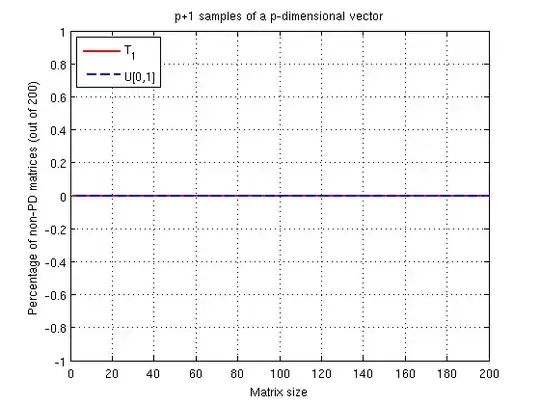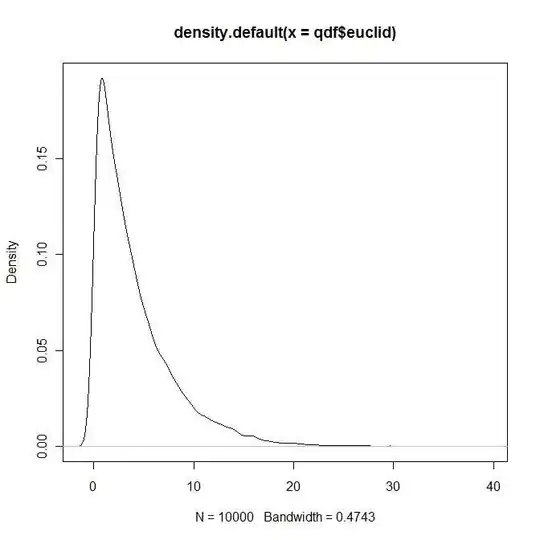I have the following lmer model:
ball6lmer=lmer(Width_mm~Buried+(Buried|Chamber), data=ballData,control=lmerControl(optimizer="optimx",optCtrl=list(method="nlminb")), REML=FALSE)
Width_mm is the diameter of dung balls made by dung beetles Buried is whether or not a dung ball was buried by a beetle (0=no, 1= yes). 26 chambers were included in the experiment and multiple dung balls came from the same chamber, so I have included the random term ~1|chamber to account for the non-independence of data. Furthermore, log likelihood tests showed that the model was improved by allowing the slopes of the Buried term to vary over chambers (random=Buried|Chamber). The output looks like this:
Linear mixed model fit by maximum likelihood ['lmerMod']
Formula: Width_mm ~ Buried + (Buried | Chamber)
Data: ballData
Control: lmerControl(optimizer = "optimx", optCtrl = list(method = "nlminb"))
AIC BIC logLik deviance df.resid
668.4 689.9 -328.2 656.4 260
Scaled residuals:
Min 1Q Median 3Q Max
-2.7717 -0.3993 -0.1455 1.0212 2.4765
Random effects:
Groups Name Variance Std.Dev. Corr
Chamber (Intercept) 0.009828 0.09914
Buried1 0.182687 0.42742 1.00
Residual 0.625589 0.79094
Number of obs: 266, groups: Chamber, 26
Fixed effects:
Estimate Std. Error t value
(Intercept) 11.14463 0.06689 166.60
Buried1 -0.92226 0.13534 -6.81
Correlation of Fixed Effects:
(Intr)
Buried1 -0.270
>
My residual plots do not look so good though:

The residuals are clearly not normal. I am now stuck as to how to proceed with this analysis. I could do a simple Mann–Whitney U test to test for a difference between Buried, however this would ignore the non-independence of dung balls from the same chamber.
The next option that I am considering is to bootstrap the regression coefficients, and obtain 95% confidence intervals for the regression coefficients. However I have never done this before and would not know where to start. So I am looking for a bit of guidance on how to proceed. Specifically:
1) Would a simple Mann–Whitney U test be an appropriate alternative or is it incorrect to ignore the non-independence of the data?
2) Is trying to bootstrap this model something that a novice like me could try or is it something best left to the professionals? If it is a relatively straight forward thing to do, could anyone recommend any basic resources to get me started?
3) Are there any other options for dealing with lmer models that violate the assumptions of normal residuals? My response variable only has 5 possible variables (width of 9,10,11,12 or 13mm) so I don’t think transforming the response variable will help.
Any guidance would be much appreciated. Thanks.
AN UPDATE:
John as correctly pointed out that I have been using the wrong predictor variable. I have now respecified the model to predict ball width based on whether or not an egg was laid in a dung ball (EggLaid, a 2 level predictor) The model is now:
lmer(Width_mm~EggLaid+(1|Chamber), data=ballData, REML=FALSE)
With the following output:
Linear mixed model fit by maximum likelihood ['lmerMod']
Formula: Width_mm ~ EggLaid + (1 | Chamber)
Data: ballData
AIC BIC logLik deviance df.resid
712.8 727.1 -352.4 704.8 262
Scaled residuals:
Min 1Q Median 3Q Max
-2.35659 -0.57566 -0.06791 0.79089 2.62157
Random effects:
Groups Name Variance Std.Dev.
Chamber (Intercept) 0.1059 0.3254
Residual 0.7636 0.8739
Number of obs: 266, groups: Chamber, 26
Fixed effects:
Estimate Std. Error t value
(Intercept) 11.0697 0.1078 102.65
EggLaid1 -0.5620 0.1119 -5.02
Correlation of Fixed Effects:
(Intr)
EggLaid1 -0.593
The QQ plot of residuals look much better, however I still have an odd looking residual vs fitted plot, which I assume reflects the 5 values of the response variable:
Is this residual plot "passable" given the 5 values of the reponse variable, or is this model not OK and I need to bootstrap the coefficients? Also to clarify, the values for width (the response) are rounded to the nearest mm.
A FURTHER UPDATE: I have had a go at bootstrapping the regression coefficients (using parametric bootsrap) using some helpful info here. My code and output is as follows:
ball2=lmer(Width_mm~EggLaid+(1|Chamber), data=ballData, REML=FALSE)
#This is the same model as the one above (output is above)
#With 5000 bootstrapped replicates
b_par<-bootMer(x=ball2,FUN=fixef,nsim=5000, use.u = FALSE, type="parametric")
#Bootstrapped CI for the intercept
boot.ci(b_par,type="perc",index=1)
#Bootstrapped CI for the EggLaid1
boot.ci(b_par,type="perc",index=2)
BOOTSTRAP CONFIDENCE INTERVAL CALCULATIONS
Based on 5000 bootstrap replicates
CALL :
boot.ci(boot.out = b_par, type = "perc", index = 1)
Intervals :
Level Percentile
95% (10.86, 11.28 )
Calculations and Intervals on Original Scale
BOOTSTRAP CONFIDENCE INTERVAL CALCULATIONS
Based on 5000 bootstrap replicates
CALL :
boot.ci(boot.out = b_par, type = "perc", index = 2)
Intervals :
Level Percentile
95% (-0.7781, -0.3469 )
Calculations and Intervals on Original Scale
I am a complete newbie to bootstrapping, so if I have made an error in the code, any suggestions would be graciously welcomed

